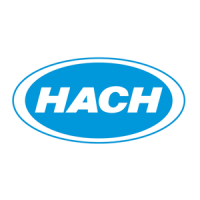33
Cyanide–1
200 mL of 7.11 M sulfuric acid / 0.79 M magnesium chloride recipe:
1. In the hood, place a 500 mL beaker on a top-loading balance
with a 400 g capacity or greater. It is best to do this in the hood
as HCl fumes will be released. Tare the balance.
2. Into the tared 500 mL beaker place 110.8 g deionized water.
Then add and dissolve completely 32.2 g magnesium chloride
hexahydrate (MgCl
2
· 6 H
2
O) in this water. Use 99% A.C.S.
reagent as any trace cyanide in this reagent will contribute to a
distillation blank.
3. Slowly add 139 g concentrated sulfuric acid in increments of 40
g at a time, swirling and allowing to cool. HCl fumes will be
released. Use the purest grade possible, as any trace cyanide
in this reagent will contribute to a distillation blank.
4. Transfer the solution to the automatic pipet container. Place the
assembled and calibrated pipet cap on loosely and allow the
solution to cool to room temperature in the hood.
5. When the solution is at room temperature, screw the cap on
tightly. Prime the pipet and the solution is ready to use in the
Cyanide–1 method.
8.3 Sources
• U.S. Environmental Protection Agency, Methods for Chemical
Analysis of Waters and Wastes, Method 335.2. EPA–600,
4–79–020, Revised March 1983.
• APHA–AWWA–WEF Standard Methods for the Examination of
Water and Wastewater, 20th ed. (1998), Method 4500–CN–N.,
pp 4–0 to 4–34.
• U.S. Environmental Protection Agency, Test Methods for
Evaluating Solid Waste, Physical / Chemical Methods
(SW–846), Method 9010B, Revision 2, December 1996, “Total
and Amenable Cyanide: Distillation”.
• U.S. Environmental Protection Agency, Methods for the
Determination of Inorganic Substances in Environmental
Samples, Method 335.4. EPA/600/R–93, August 1993.
• U.S. Environmental Protection Agency, Test Methods for
Evaluating Solid Waste, Physical / Chemical Methods
(SW–846), Method 9213, Revision 0, December 1996,
“Potentiometric determination of cyanide in aqueous samples
and distillates with ion-selective electrodes”
8.4 USEPA Method 335.2 Scaled-Down
For 6.0 mL of Micro Distilled Sample, the scale-down factor for this
batch colorimetric method is 6/50 or 0.120. Here, the changes we
suggest in apparatus or technique are [added in brackets]. The
scale-down gives the same concentrations of reagents, sample,
and analyte from Section 8.7, p 335.2–4 (see section 8.3 on
page 33):
8.7 Withdraw 6.0 mL of the solution from the flask [collector tube]
and transfer to a 20 mL erlenmeyer flask. Add 1.80 mL of sodium
phosphate solution (7.6) and mix.

